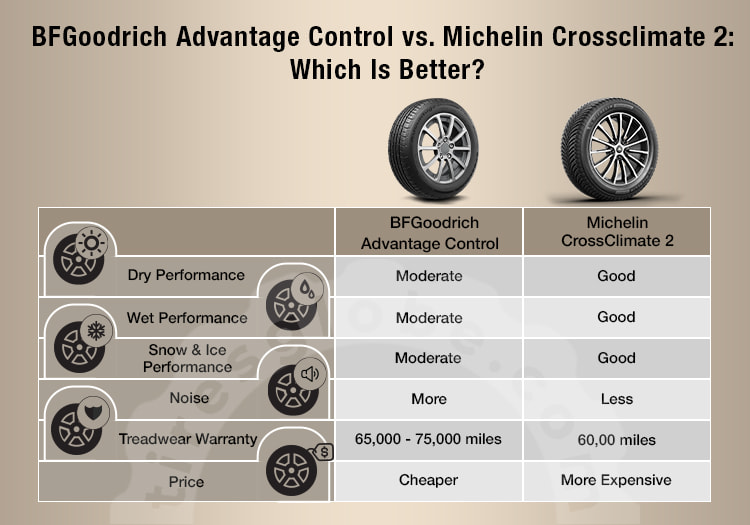Which should you choose between the BFGoodrich Advantage Control and the Michelin CrossClimate 2
If you haven’t made up your mind yet, then read on.
This article will provide a comprehensive comparison of these tires, evaluating their performance across various criteria. Ultimately, you’ll be able to pick the one that aligns best with your needs.
BFGoodrich Advantage Control vs. Michelin Crossclimate 2: Comparison Overview
Let’s take a quick look at the performance differences between Goodyear Assurance WeatherReady and Michelin CrossClimate 2 tires in the comparison overview below:


BFGoodrich Advantage Control

Michelin Crossclimate 2
BFGoodrich Advantage Control vs. Michelin Crossclimate 2: Detailed Comparison
Dry Performance
When comparing dry pavement performance, we prefer the Michelin CrossClimate over the BFGoodrich Advantage Control.
The Michelin tires offer superior traction, providing a more confident driving experience with improved steering and braking capabilities.
This enhanced performance may be thanks to the beveled tread block edges, optimizing the tire’s contact patch for more efficient braking on dry roads. Besides, the level edge shape of the blocks also maximizes ground contact, which results in improved dry stopping distance.
However, a downside is their tendency to easily pick up small pebbles when you are driving on gravel roads.
On the other hand, the BFGoodrich Advantage Control performs moderately well on dry surfaces. In particular, the continuous center rib design provides stability at higher speeds, as only a small section of the tire’s center touches the ground at such speed.
Yet, we notice that these tires have quite a long braking distance, and you need to lower the air pressure in the tires to improve it. They are somewhat softer, requiring a bit of time for adjustment to get used to the feel on dry pavement, particularly when making a lane change maneuver. So, they perform adequately overall but struggle somewhat during turns and braking.
Wet Performance
In wet weather, the Michelin CrossClimate 2 outperforms the BFGoodrich Advantage Control. We base this assessment on its superior abilities in wet traction, cornering, and stopping.
The Michelin tires are designed to effectively handle wet surfaces by maximizing water evacuation and improving resistance to hydroplaning. This is achieved through the V-shaped grooves that efficiently clear water from the center of the tread to the shoulders, both when the tires are new and when they wear down.
Conversely, the BFGoodrich Advantage Control performs decently in wet weather. These tires feature deep channels that evacuate water through the outer tread blocks. However, their performance in wet conditions isn’t as impressive as that of the Michelin tires.
Snow Performance
The Michelin CrossClimate 2 is 3-peak Mountain SnowFlake rated, indicating its suitability for light to moderate snow conditions, whereas the BFGoodrich Advantage Control lacks this specific rating.
However, it’s not that the BFGoodrich tires can’t handle snow at all. They feature full-depth sipes in each tread block, making them suitable for occasional light wintry conditions.
Meanwhile, the Michelin tires are equipped with thermal adaptive compound and 3D self-locking sipes. These sipes create extra biting edges, improving traction in cold weather and snow without compromising grip on dry surfaces. So, if you’re looking for an all-season tire with good snow performance as a priority, the Michelin option might be the better choice for you.
Noise
Both tires make some road noise, with the Michelin CrossClimate 2 being the quieter. As these tires age, the noise tends to increase, but it’s not so loud that it greatly affects your driving experience.
On the other hand, the BFGoodrich Advantage Control tires produce a slightly more noticeable noise. However, it’s not excessively loud or irritating either.
Treadwear Warranty
The BFGoodrich Advantage Control provides a more extended treadwear warranty than the Michelin CrossClimate 2.
With the BFGoodrich Advantage Control, H-rated tires have a 75,000-mile treadwear warranty, and V&W-rated tires come with a 65,000-mile warranty.
Conversely, the Michelin CrossClimate 2 offers a mileage warranty of 60,000 miles across all its tires.
Price
Between the two tires, the BFGoodrich Advantage Control is more budget-friendly compared to the Michelin CrossClimate 2.
The BFGoodrich tires are priced between $113.00 and $238 per tire, with the cost varying based on the specific tire size you choose
On the other hand, the Michelin CrossClimate 2 comes at a higher price range, starting at around $170 and increasing up to $382 per tire. Similar to BFGoodrich, the price fluctuates according to the chosen tire size.
Final Recommendations
For overall superior performance in various driving conditions, the Michelin CrossClimate 2 is the better tire choice. It excels in dry, wet, and light snow conditions, offering great traction and handling.

BFGoodrich Advantage Control
Meanwhile, the BFGoodrich Advantage Control will suit your needs if you’re searching for a more affordable option with a longer treadwear warranty. However, note that this tire only offers decent performance.

BFGoodrich Advantage Control
Read more: Goodyear Assurance WeatherReady vs. Michelin Crossclimate 2: Which Is Better?
